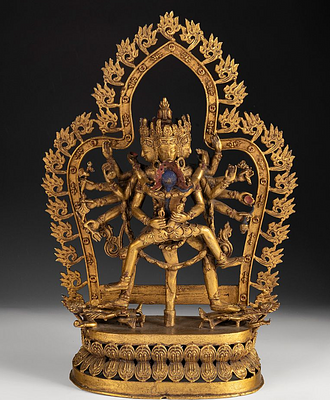Beasts. China, 19th century. Ivory polychrome. Base in carved wood. Signed at the base.
Lot 123
About Seller
Setdart Auction House
Carrer Aragó 346
Barcelona
Spain
Setdart Subastas was born in 2004 and is currently the first online art auction in Spain with solidity, prestige and reliability guaranteed by our more than 60,000 users. Setdart has a young, dynamic and enterprising team ready to successfully manage the purchase and sale of art works through custom...Read more
Estimate:
EUR€1,800 - EUR€2,000
$1,935.48 - $2,150.54
Absentee vs Live bid
Two ways to bid:
- Leave a max absentee bid and the platform will bid on your behalf up to your maximum bid during the live auction.
- Bid live during the auction and your bids will be submitted real-time to the auctioneer.
Bid Increments
| Price | Bid Increment |
|---|---|
| EUR€0 | EUR€10 |
| EUR€200 | EUR€25 |
| EUR€500 | EUR€50 |
| EUR€1,000 | EUR€100 |
| EUR€3,000 | EUR€200 |
| EUR€5,000 | EUR€500 |
| EUR€10,000 | EUR€1,000 |
| EUR€20,000 | EUR€2,000 |
| EUR€50,000 | EUR€5,000 |
About Auction
By Setdart Auction House
Jun 16, 2021
Set Reminder
2021-06-16 06:15:00
2021-06-16 06:15:00
America/New_York
Bidsquare
Bidsquare : Oriental Art Collection
https://www.bidsquare.com/auctions/setdart-auction-house/oriental-art-collection-7080
Setdart Auction House sofia@setdart.com
Setdart Auction House sofia@setdart.com
- Lot Description
Beasts. China, 19th century. Ivory polychrome. Base in carved wood. Signed at the base. Attach import certificate endorsed by the Ministry of Economy, prior to the entry into force of the Cites Certificate. Weight: 1385 gr. Measurements: 10 x 27 cm. Sculptural group in carved ivory representing two fierce lions struggling between life and death, in a violent melee. The sculptor adapts the aggressive movements of the animals to the material with which he works, creating an elongated figure that takes advantage of the available ivory. The beasts have been worked with remarkable naturalism, accurately reproducing the anatomy of both, and are entirely covered by carved and chiseled motifs. The fur, highly individualized in each of the beasts, a characteristic aspect of Chinese ivory carvings, denotes the skill of the craftsman, who perfectly reflects the anatomical details of the animals. We are faced with sculptures made with a modeling of great naturalism, which nevertheless combines a certain idealization in areas such as the face, respecting the volumes of the anatomy of the animals. In this way, images of a greater nobility and timeless sense are obtained, ideal for the decoration of a large house. These types of representations, although already present in Antiquity, have their direct origin in the animalistic sculpture of the 19th century. During that century, animal-themed statuary finally achieved its own status within the context of Romantic sculpture. Seeking to break away from the classical sculptural ideal, many artists saw in the animal theme a new way of expression, linked to the emotional and irrational nature, in a purely romantic sense that in works such as those presented here, however, is combined with a certain air of serene nobility clearly classical. On the other hand, these are lions, animals endowed with a deep symbolism throughout the history of oriental art. On the one hand, the Foo lion (or protective lion), similar to a dog, is an important symbol in Chinese Taoist culture and, due to its influence, also in Japanese culture. It is identified with protection against evil spirits, and hence they are usually represented in pairs at the entrance of the temples, the male resting his claw on a sphere and the female protecting a cub; on the other hand, they are synonymous with strength and courage, the lion is considered the king of land animals, solar beast and closely related to light, among other reasons for its strength, its golden color and the radial distribution of its mane."
Dimension
Height: 10.00 cmWidth: 27.00 cm - Shipping Info
-
In-house shipping available. Please inquire at admin@setdart.com.
-
- Buyer's Premium



 EUR
EUR CAD
CAD AUD
AUD GBP
GBP MXN
MXN HKD
HKD CNY
CNY MYR
MYR SEK
SEK SGD
SGD CHF
CHF THB
THB






